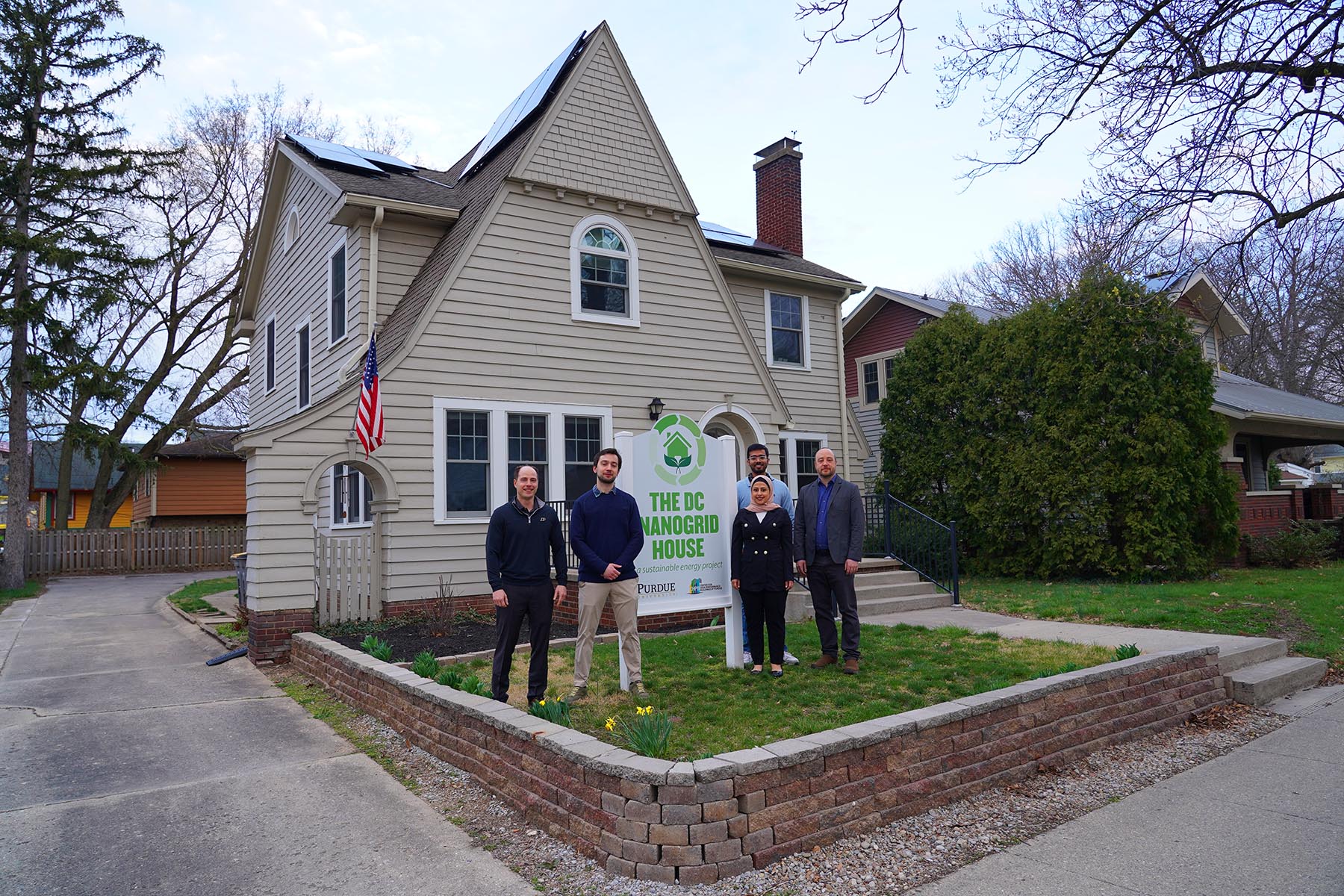Let go of the thermostat: predictive heating control system demonstrates huge energy savings

“A heat pump is just an air conditioner in reverse — using electricity to remove heat from the outside and transfer it inside,” said Kevin Kircher, assistant professor of mechanical engineering, and an acknowledged expert on heat pumps and home electrification. “Using electricity in this way is far more efficient than the heating systems in most of our homes, with the added benefit of burning less fossil fuel.”
One of the biggest issues to the adoption of heat pumps is the perceived cost, both of the equipment itself and its continued operation. “Heat pumps can increase electricity demand,” said Elias Pergantis, a Ph.D. student co-advised by Kircher and Davide Ziviani. “What we wanted to find out is how we can use machine learning and predictive control to reduce the energy required, but still maintain the same level of human comfort.”
Purdue has a unique living laboratory to test their theories. The DC Nanogrid House is a 1920s-era West Lafayette, Indiana home retrofitted with solar panels, batteries, electric appliances, electric heat pumps, and a bevy of sensors in every room. Graduate students live at the house, serving as test subjects for researching human comfort and new smart home technologies.
“Most people adjust the temperature in their home by manually operating a thermostat — they feel cold, so they push the button to make the temperature go up,” said Pergantis. “But when they do that, they don’t take into account the predicted solar radiation, the humidity, the forecasted temperature that day, or which rooms they’re going to occupy in the house, and for how long. As a result, most of the time they end up overheating their house and wasting energy. Even the best ‘smart’ thermostats don’t incorporate all this information.”
Thankfully for Pergantis, the DC Nanogrid House has a plethora of sensor data on the temperature of the house, historic climate data, and which parts of the house are occupied when. So Pergantis used this data to build a model for predictive control using machine learning, which he could then verify based on actual conditions observed at the house.
Then it was time for an experiment. “We implemented the algorithm in the middle of winter,” said Pergantis. “Basically for a month and a half, the algorithm predicted when the house would need heating, in which rooms, and how many kilowatts it would take. The human occupants could adjust set points, but for the most part, the computer took charge of the thermostat.”
The results were striking. During the 40-day test of the model predictive control system, the house consumed 19% less energy than a comparable stretch from a previous winter. In dollar terms, that’s a $300 energy savings for just one household. Extrapolated to all US households, that’s a total savings of more than $22 billion every year.

And what about the comfort of the home’s occupants? How do you scientifically gauge whether people “felt” cold throughout the experiment?
“We have two methods of quantifying comfort,” said Kircher. “One uses a complex mathematical formula to estimate when typical subjects would feel discomfort; the other involves quick digital surveys of the occupants, which we conduct before, during, and after the experiment. Both methods showed a near equal amount of time that the occupants ‘felt’ cold, both during the model predictive control experiment, and during normal operation. In short, our occupants had the same level of comfort with model predictive control, but with much less energy being used.”
Their research has been published in Applied Energy.
“This approach has many other side benefits,” said Pergantis. “As we increase our demands on the electricity grid, having predictive control like this can help reduce the chances of spikes or brownouts. And this also has the chance to help low-income families, for whom utility bills can be a huge burden; reducing their electricity bill by $300 or more per year can really help to lift that burden.”
The results also suggest a change in the way we think about heating and cooling our homes. “We’ve demonstrated that a data-rich predictive control system can save electricity, with no impact on human comfort,” said Kircher. “What we envision is a thermostat that doesn’t use degrees, but operates in modes, like your car. In ‘Eco’ mode, you reduce the operation time, but save huge amounts of energy. In ‘Performance’ mode, you can blast the heat for a short period of time before returning to normal.”
The DC Nanogrid House is one of multiple initiatives of the Center for High Performance Buildings, a Purdue organization dedicated to partnering with industry and academia to advance the technologies of smart homes and high-performance buildings. Purdue hosts the largest academic HVAC lab in the world at Herrick Labs, including a unique building-within-a-building facility that tests smart home technologies and their impact on human comfort.
“Data is the key,” said Kircher. “Based on just one month of data, we could build a relatively simple model for predictive heating, which demonstrated tangible energy savings in a real-world home. Imagine expanding that technology to a neighborhood, a city, or the entire country.”

Pergantis' work is supported by the Onassis Foundation, and a grant-in-aid from the American Society of Heating, Refrigerating and Air-Conditioning Engineers (ASHRAE).
High-performance building research is among numerous Purdue interdisciplinary initiatives designed to address research in and advancement of AI technologies, including the Purdue Computes initiative and Purdue’s Institute for Physical AI.
Writer: Jared Pike, jaredpike@purdue.edu, 765-496-0374
Source: Kevin Kircher, kircher@purdue.edu
Elias Pergantis, epergant@purdue.edu
Field demonstration of predictive heating control for an all-electric house in a cold climate
Elias N. Pergantis, Priyadarshan, Nadah Al Theeb, Parveen Dhillon, Jonathan P. Ore, Davide Ziviani, Eckhard A. Groll, Kevin J. Kircher
https://doi.org/10.1016/j.apenergy.2024.122820
ABSTRACT: Efficient electric heat pumps that replace fossil-fueled heating systems could significantly reduce greenhouse gas emissions. However, electric heat pumps can sharply increase electricity demand, causing high utility bills and stressing the power grid. Residential neighborhoods could see particularly high electricity demand during cold weather, when heat demand rises and heat pump efficiencies fall. This paper presents the development and field demonstration of a predictive control system for an air-to-air heat pump with backup electric resistance heat. The control system adjusts indoor temperature set-points based on weather forecasts, occupancy conditions, and data-driven models of the building and heating equipment. Field tests from January to March of 2023 in an occupied, all-electric, 208 m2 detached single-family house in Indiana, USA, included outdoor temperatures as low as −15°C. On average over these tests, the control system reduced daily heating energy use by 19% (95% confidence interval: 13%–24%), energy used for backup heat by 38%, and the frequency of using the highest stage (19 kW) of backup heat by 83%. Concurrent surveys of residents showed that the control system maintained satisfactory thermal comfort. The control system could reduce the house’s total annual heating costs by about $300 (95% confidence interval: 23%–34%). These real-world results could strengthen the case for deploying predictive home heating control, bringing the technology one step closer to reducing emissions, utility bills, and power grid impacts at scale.
